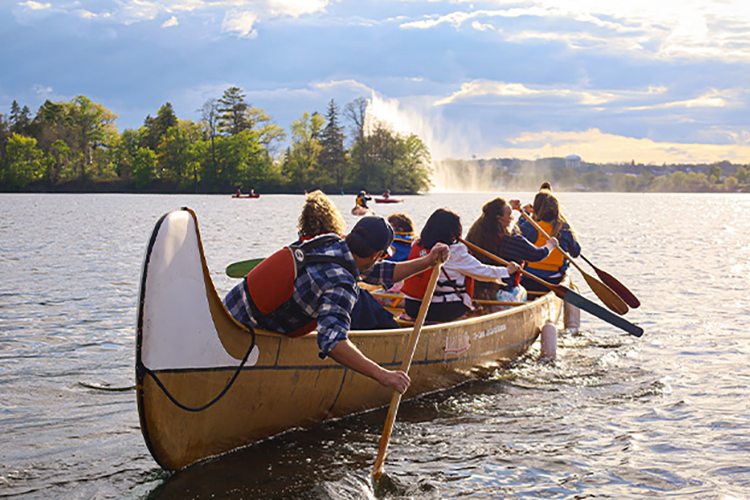Canadian Canoe Museum
Located on the shore of Little Lake, the Canadian Canoe Museum boasts the largest collection of paddled watercrafts in the world. The museum is dedicated to preserving and sharing the culture and history of the canoe.
Canoes were originally created by Indigenous people to navigate lakes and rivers across the continent. The Canadian Canoe Museum was recognized for its cultural importance by the Canadian Senate in 2013. Its state-of-the-art facilities surrounded by nature and an impressive collection and interactive exhibits, help connect visitors to Canada’s rich canoe heritage.
Canadian Canoe Museum | Justen Soule
How to get to Canadian Canoe Museum
Location: 2077 Ashburnham Drive, Peterborough
By car: The Canadian Canoe Museum is located 90 minutes east of Toronto in Peterborough. It can be reached via the ON-115 North, the ON-69 South or the Trans-Canada Highway. Free parking is available on-site and at nearby lots.
By transit: GO Transit offers service between Toronto and Oshawa. GO Transit Bus 88 travels between Durham Collage Oshawa GO and Trent University in Peterborough.
During the summer and fall, the Canoe Bus is a round-trip coach service from Toronto to the museum.
Know before you go
Canadian Canoe Museum is open daily from 10:00 a.m. to 5:00 p.m. On Thursdays, the museum closes at 8:00 p.m.
Admission tickets can be purchased in person or online.
If you’re renting a canoe or kayak or participating in a Voyage Canoe group tour, you must always wear a personal flotation device on the water.
Things to do at Canadian Canoe Museum
Discover more activities and experiences.
View historical canoes
Tour the museum’s expansive collection, which includes skin-on-frame kayaks from Baffin Island, bark canoes from Newfoundland and watercraft from Paraguay and the Amazon.
Join canoe workshops
Learn about canoe construction, build your own birch bark canoe, or plan a prospective canoeing expedition in an immersive workshop.
Paddle on Little Lake
Join a guided group tour with Voyageur Canoe Tours, rent a canoe or kayak or bring your own boat for a paddle.
Paddling for kids and youth
Certified canoe guides help youth connect with tranquil nature at day camps spent paddling or canoe trip expeditions in provincial parks.
Take a canoeing course
Refine your paddling skills and earn a canoe certification from skilled instructors.
Buy canoe-themed gifts
Shop for canoe-inspired items at the Canadian Canoe Museum Store. This curated collection features clothing, books and unique creations by local, Canadian and Indigenous artists.
Articles and itineraries
Get ideas and inspiration for your next trip.

Interesting facts about the Canadian Canoe Museum
With over 600 canoes, kayaks and other paddled watercraft, and over 1,000 related artifacts, this museum’s collection is one of a kind. Items in the collection hail from around the country, coast to coast.
It grew out of Professor Kirk Wipper’s personal collection and was originally founded as the Kanawa Museum in 1957. The museum took on its new name in 1997 and has been presenting this unique take on Canada’s cultural heritage ever since.
Accessibility Features
Accessible drop-off location
Accessible entrances/exits
Accessible parking
Accessible transportation
Accessible washroom
Elevator access
Service animals welcome
Support persons welcome
Wheelchair accessible
Wheelchair and/or mobility devices available
Last updated: August 29, 2024




